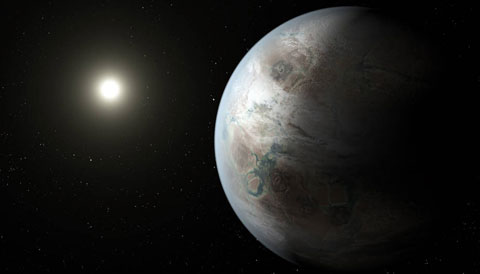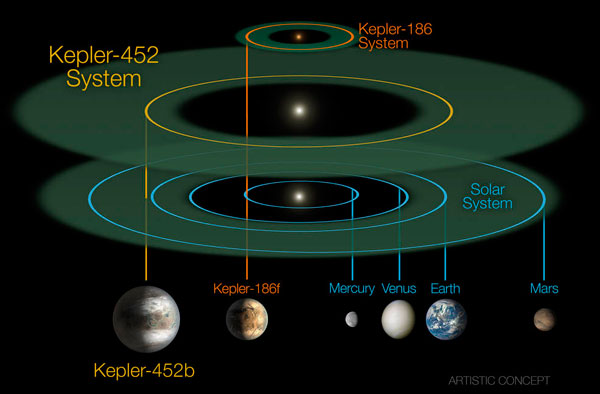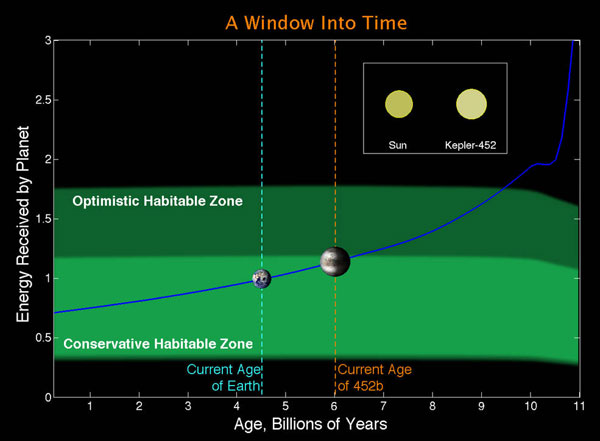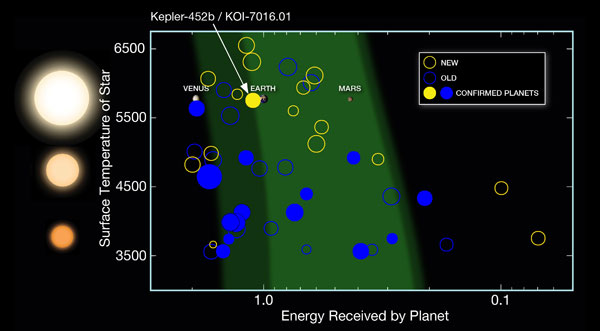The Kepler team announced today the discovery of Kepler-452b, an Earth-size planet in the “goldilocks” zone around a Sun-like star. But is it Earthlike?

NASA / JPL-Caltech / T. Pyle
Kepler-452b sure seems a lot like Earth. This exoplanet has a radius 1.6 times that of our home world and orbits its Sun-like (read: G-type) star every 385 days. That puts it well within the stars’ habitable zone, that fuzzy theoretical region where a planet’s hypothetical surface could support water.
This is the first planet to meet all three criteria (Earth-size, habitable-zone orbit, and Sun-like star), making it the closest cousin to Earth found so far.
But is Kepler-452b really Earthlike? That remains to be seen . . . in fact, it may never be seen. To even begin guessing about a planet’s composition, you have to start with its density, and for that you need its mass. There’s no way to measure mass directly from Kepler data, and the planet is too small and faint for ground-based follow-up. (The planet candidate was confirmed using statistical methods rather than observations.)

NASA / JPL-CalTech / R. Hurt
What the Kepler team does have is the planet’s physical size. Jon Jenkins (NASA Ames Research Center) and colleagues and others compared that size to other small exoplanets whose size and mass are known, and estimated the planet’s mass to be between 3 and 7 Earth masses.
“We probably won't be able to make a direct mass measurement of this planet anytime soon,” says Jenkins. But what the team can do is refine the planet’s size still further. The planet’s size measurement depends on the star’s size, and measuring that depends on knowing the star’s precise distance, something which the Gaia space telescope will return in a year or two. Even then, Jenkins adds, “we'll have a better idea [of the mass], but it will still be a statistical estimate and not a direct measurement.”
The size measurement and mass estimate put the planet smack in the middle of the dividing line between super-Earths, planets slightly bigger than Earth with rocky surfaces, and sub-Neptunes, planets slightly bigger than Earth with a significant gaseous envelope. As Jenkins put it in a press conference today, “This planet has a somewhat better than even chance of being rocky.”

NASA Ames / J. Jenkins
But that’s not all the team knows about this system. The astronomers are also studying the stellar host: a G-type solar sibling 1.5 billion years older than the Sun, according to stellar evolution models.
“Stars are like people,” Jenkins said at the press conference. “When they’re young, they’re small and dim. When they grow older, they fill out, slow down, and they get brighter.” The star is now 10% larger and 20% brighter than our Sun (though its visible-surface temperature remains the same) — serving as a glimpse into the future of our solar system.
Though the team can’t study the planet’s atmosphere, they consulted planetary geologists and atmospheric scientists to draw the artist’s concept shown above. If it’s rocky with five times Earth’s mass, it would have twice Earth’s surface gravity. It might have significant cloud cover and active volcanoes. Those models also show that the higher influx of radiative energy could soon (in the astronomical sense) put the planet on the brink of a runaway greenhouse effect like the one that boiled away Venus’s oceans a billion years ago.
The Kepler Pipeline

NASA Ames / W. Stenzel
The announcement of Earth’s closest cousin yet comes as part of Kepler’s 7th data release, which netted 521 new planet candidates, including 12 new Earth-size (less than twice Earth’s diameter) planets in their stars’ habitable zone. The tally of confirmed planet has risen to 1,030, up from 1,013 in January.
Kepler has changed its mission, so no new observations are rolling in. It’s the software improvements that enabled researchers to bag new candidates, and an 8th catalog with further improvements is planned for next year.
With a fully automated pipeline, the Kepler team can now mimic the decisions that researchers were making manually. That means that all of the planet candidate detections can be re-evaluated using the full dataset, a feat not possible before. According to Jeff Coughlin (SETI Institute), some 600 new planet candidates were discovered, but another 100 were demoted from candidate status (mostly due to background eclipsing binary stars that mimicked a planet's signal), bringing the total new candidates to 521.
“We still think we have a very high, more than 95%, reliability rate of our planet candidates,” Coughlin adds.
Reference:
Exoplanet-hunting isn't just for the professionals. Take part in the hunt — read how you can join in Sky & Telescope's March 2014 issue.
 9
9









Comments
Lindsay
July 24, 2015 at 6:05 pm
Will scientists be able to look for spectroscopic evidence of oxygen in the atmosphere of Kepler-452b as it transits its star?
You must be logged in to post a comment.
Monica YoungPost Author
July 26, 2015 at 9:02 pm
We could only wish! Unfortunately, this planet is simply too small for us to make out its atmosphere, even with future instruments.
You must be logged in to post a comment.
July 24, 2015 at 6:35 pm
I didn't see anything in the post as to what constellation this is in.
You must be logged in to post a comment.
William-Perkins
July 24, 2015 at 7:01 pm
Nice article. Is this a K2 result or a result of new processing of the previous datasets? Very interested in the automated pipeline. Is this automated statistical analysis that uses the whole dataset described anywhere? I looked at the Kepler website and the most recent description of the pipeline is from 2011. Would be interesting to see the analysis from raw FITS data to calibration to light curve to statistical test of periodic millimagnitude variation above noise.
You must be logged in to post a comment.
Monica YoungPost Author
July 26, 2015 at 9:08 pm
These results are from processing of the four years of data before K2. The paper (published in Astronomical Journal) wasn't available when I first posted, but I've added it now. Unfortunately, it doesn't seem to be available on the preprint arXiv.
You must be logged in to post a comment.
July 27, 2015 at 12:55 pm
The preprint of the discovery paper is now available via arVix:
http://arxiv.org/abs/1507.06723
You must be logged in to post a comment.
William-Perkins
August 1, 2015 at 6:29 pm
Thank you. Following up on the lead you provided, I found the automated method described in an ArXiv ApJ preprint, AUTOMATIC CLASSIFICATION OF KEPLER PLANETARY TRANSIT CANDIDATES, DOI: 10.1088/0004-637X/806/1/6. Sean McCauliff, Jon Jenkins and others use a random forest machine learning algorithm (a matlab program) to classify findings in the 16 quarter Kepler dataset as planet candidate, astronomical false positive or non-transiting phenomena. Thought they might be using a machine learning approach, something that will be essential in next-generation high-output surveys, such as LSST. While the new result is great, the method used is even greater. Thank you for bringing it to my attention.
Here is a pointer to the .pdf of the ArXiv ApJ preprint, if you are interested.
http://arxiv.org/pdf/1408.1496v2.pdf
You must be logged in to post a comment.
July 27, 2015 at 1:15 pm
While Kepler 452b seems to orbit inside of its star's habitable zone and would have been more comfortably inside it earlier in its 6 billion year history, the assessment that it has better than even odds of being a rocky or terrestrial planet is on a bit shakier grounds. A review of the discovery paper shows that Jenkins et al. used a couple of different sets of numbers applied to a couple of different published mass-radius relationships for sub-Neptune planets in order to estimate the probability that their find is a rocky planet. They ended up with figures running from 40% to 62% and simply adopted an optimistic ">50%" probability.
A better approach to estimate the probability that Kepler 452b is a rocky planet instead of a mini-Neptune with poor prospects of being habitable would be to compare the properties of their find directly with the observed population of sub-Neptune sized exoplanets with good mass determinations. A recently published paper by Leslie Rogers (a Hubble Fellow at Caltech) performed a rigorous statistical analysis of Kepler discoveries and found that the population of exoplanets seems to transition from being mostly rocky to mostly mini-Neptunes at a radius no greater than 1.6 times that of the Earth (which just happens to be the measured radius of Kepler 452b) to a 95% confidence level. In fact, the likelihood that Kepler 452b is a mini-Neptune is stated in the title of the paper itself: “Most 1.6 Earth-Radius Planets are not Rocky”, The Astrophysical Journal, Vol. 801, No. 1, Article id. 41, March 2015
Based on this mathematically more rigorous and accurate approach, the odds that Kepler 452b is a rocky planet is probably closer to 40% than the adopted >50% figure. But whether Kepler 452 is a rocky planet or not, or even habitable or not, future detailed studies of this interesting world will shed much light on the limits of planetary habitability.
You must be logged in to post a comment.
Hussain-Almousawi
August 4, 2015 at 11:56 pm
By all means, let the search go on! Debates on this issue sure will be too many with too many verifications. It looks like that we are on the right track in finding Earth like planet. But we may find in the future some more advanced facilities to pinpoint what we are looking for. Every day we are getting some new astronomical knowledge on the universe. It is just we that stars change their birth places even orbits and migrate to another places in the galaxies. So we have too many, not just cousins, but (multiple twins) of brothers and sisters, to our star, in the M.W. galaxy.
One point I have to highlight, that our own earth can help us finding her similarity, by fully studying the Earth itself (as an alien planet) from far, will tell us what planets are similar or closer to it in other places. And there has to be plenty probably in millions if if not billions. As universe and nature has verifications, has copies as well in all aspects. It is like apples from one tree all look same but all same!
Although it is very important but let us leave the mathematic aside, think logic and simple. We will see what can be found on our planet can be on another if the natural building blocks, time and all conditions are similar. Let us study our Earth we will find her partners.
You must be logged in to post a comment.
You must be logged in to post a comment.